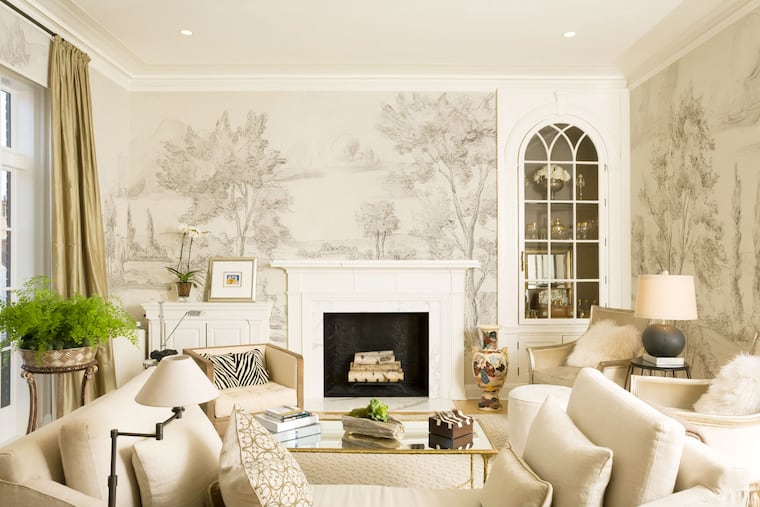Scenic wallpaper murals now more accessible than ever
Thanks to digital-printing technology that allows retailers to duplicate the look inexpensively, you no longer have to blow your entire decorating budget on a few pricey panels of chinoiserie.

Designers love scenic wallpaper for its ability to transform a room. Unlike regular wallpaper, which often has a repeating pattern, scenic wallpaper fills an entire wall with a single, mural-like image. Usually depicting an outdoor tableau, the wallpaper brings nature inside and lends old-world appeal to a space. Just flip through any recent design magazine and you’ll probably see a well-appointed room with walls covered in large-scale images of flowering vines or swaying trees.
“People embrace things that feel handmade and have a link to the past,” says Susan Harter, who makes hand-painted scenic wallpaper in her Port Townsend, Wash., studio. “At a time when we’re being bombarded with technology, it’s nice to be in a haven of one’s own making. It’s like entering a peaceful mini-Eden.”
Until recently, if you wanted the look, you had to splurge on custom wallcoverings from luxury brands such as Zuber et Cie, Gracie Studio, de Gournay and Fromental. Those handmade paper or silk panels can cost thousands of dollars, and that’s without installation.
But scenic wallpaper has become far more accessible. Thanks to digital-printing technology that allows retailers to duplicate the look inexpensively, you no longer have to blow your entire decorating budget on a few pricey panels of chinoiserie.
High-definition printers aren’t exactly new to the luxury wallpaper business; the London-based brand Iksel has been producing high-end digital collections based on hand-painted works since 2004. And Harter’s company, Susan Harter Muralpapers, has been using the technology for several years to turn her hand-painted murals into custom canvas wallcoverings.
Now, mass-market retailers are getting in the game: Anthropologie, Minted, Tempaper and U.K.-based Woodchip & Magnolia are just a handful of the companies offering lower-priced versions, making it easier than ever to embellish a blank wall with a painterly image of a meadow or garden. Wallpaper murals from Anthropologie and Woodchip & Magnolia can be ordered online for less than $300.
Even renters can upgrade their space with a nature-inspired scene: Minted offers abstract landscapes created by independent artists in peel-and-stick panels, starting at $330, and Tempaper’s removable wallpaper features chinoiserie-inspired blooms and lush tropical foliage at $12 a square foot.
Scenic wallpaper has been enlivening homes for more than 300 years. Most examples can be traced back to two different styles: Chinese panels and French panoramic scenes. According to Greg Herringshaw, assistant curator of wallcoverings at the Cooper Hewitt Smithsonian Design Museum in New York, the earliest examples of hand-painted decorative panels came from China in the late 17th century. They often featured flowers, birds and trees, or tradesmen at work, and were rendered in an intentionally naive, shallow perspective. The popularity of chinoiserie soared through the 19th century, and the wallpaper made its way to Europe and the United States as an import from the East India Company, following the trade routes of the time.
French panoramic papers used a more realistic perspective and showed highly detailed landscapes. The first documented example of a panoramic paper appeared in France around 1803. It was block-printed by hand and attributed to Zuber et Cie, the oldest still-operating wallpaper company.
“Early French papers were meant to be travelogues that fit with the whole idea of the grand tour, depicting scenes of Roman ruins or exotic lands,” Herringshaw says.
Zuber still uses the same labor-intensive technique, which involves carving designs onto wooden blocks, dipping the blocks into hand-mixed pigments, and stamping them onto paper.
Because of its expense and dramatic appearance, scenic wallpaper has traditionally been used in high-traffic rooms where visitors would be impressed by such a lavish display. (A fine example of Zuber paper adorns the Diplomatic Reception Room in the White House.) Today, you're still most likely to spot the wallcoverings in places where guests congregate, especially dining rooms.
“There isn’t usually as much furniture to obstruct the view,” says Alexandria, Va., designer Shazalynn Cavin-Winfrey. “The table and chairs are generally centered in the room as opposed to sitting on the periphery, and they also tend to be more formal spaces.”
The newfound accessibility of scenic wallpaper helps homeowners solve a variety of routine design problems. Take the ever-present open floor plan: “Murals are the perfect way to define a space,” says Northern Virginia designer Alison Giese, who used one to delineate a dining room in an open-concept living area.
And for the space-challenged, a scenic landscape can make a big difference. "It seems counterintuitive, but a mural can make a small space feel much larger," Herringshaw says.